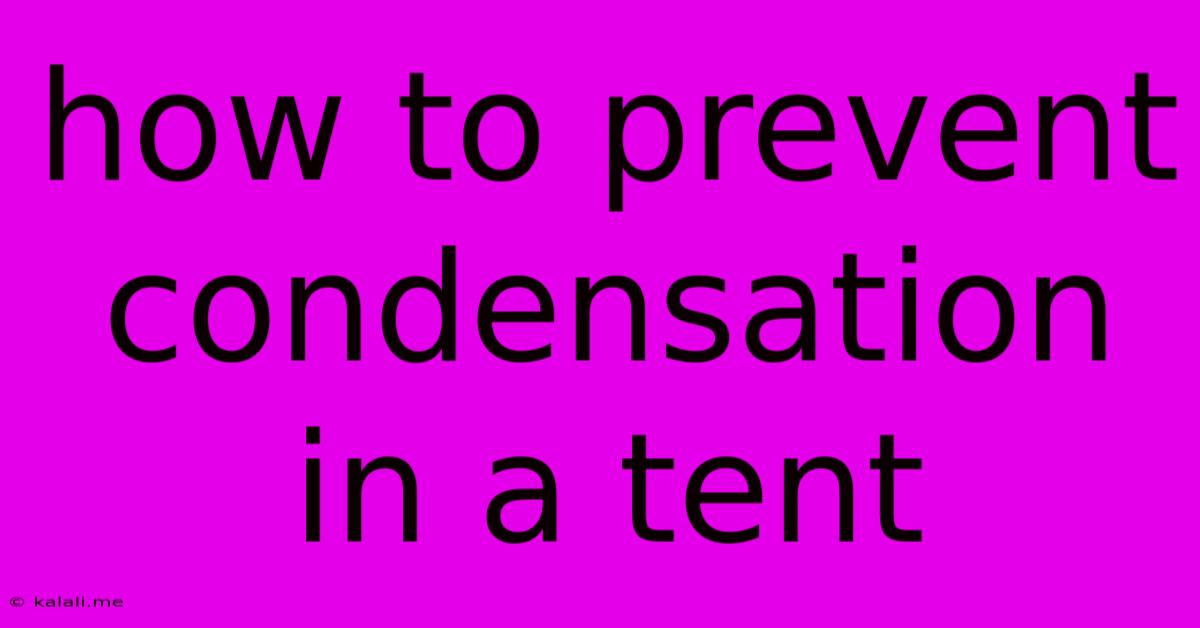How To Prevent Condensation In A Tent
Kalali
May 22, 2025 · 3 min read

Table of Contents
How to Prevent Condensation in Your Tent: A Comprehensive Guide
Condensation in a tent is a frustratingly common problem, leaving your gear damp and your sleeping experience uncomfortable. But don't despair! This guide provides practical strategies and preventative measures to keep your tent dry and enjoyable, no matter the weather. Learn how to minimize moisture buildup and enjoy a comfortable camping experience.
Understanding Tent Condensation: The Root of the Problem
Before diving into solutions, it's crucial to understand why condensation forms. Simply put, warm, moist air inside your tent meets the cooler surfaces of the tent fabric, causing the water vapor to condense into visible droplets. Several factors contribute to this:
- Temperature Differences: The most significant factor. A large temperature difference between the inside and outside of your tent accelerates condensation.
- Moisture Levels: Breathing, cooking, and even damp clothing release moisture into the air.
- Ventilation: Poor air circulation traps moisture, making condensation more likely.
- Tent Material: Some tent materials are more prone to condensation than others.
Effective Strategies to Prevent Tent Condensation
Here’s a breakdown of practical steps you can take to significantly reduce condensation in your tent:
1. Improve Ventilation: This is arguably the most crucial step.
- Open vents: Always utilize all available vents, even in slightly damp conditions. Proper air circulation is key to equalizing temperature and humidity.
- Strategic placement: Ensure vents are positioned to allow for maximum airflow. Avoid blocking them with gear or sleeping bags.
- Mesh inner tents: Opt for tents with mesh inner tents. They allow for superior breathability compared to solid fabric.
2. Manage Moisture Sources: Minimize moisture production within the tent.
- Air out sleeping bags: Before entering your tent, shake out and air out any damp sleeping bags or clothing.
- Limit cooking: If cooking inside the tent is unavoidable, use a stove with minimal moisture output. Consider cooking outside whenever possible.
- Dry clothes before sleeping: Avoid bringing wet clothes or gear into your tent. Hang them outside to dry if possible.
3. Choose the Right Tent: Consider these features when purchasing a new tent:
- Breathable materials: Look for tents made from breathable fabrics that allow for better moisture regulation.
- Good ventilation system: Check for multiple vents, strategically placed for optimal airflow.
- Footprint: Using a footprint underneath your tent can add a layer of protection against ground moisture.
4. Optimize Your Camping Setup:
- Campsite selection: Avoid pitching your tent in low-lying areas where moisture tends to accumulate.
- Pitching technique: Ensure your tent is properly pitched to avoid pooling water and allow for maximum ventilation.
Additional Tips and Tricks
- Desiccant Packs: These small, moisture-absorbing packets can help absorb excess humidity inside your tent.
- Use a tent footprint: This protects the tent floor from moisture and can also help insulate against cold ground temperatures.
- Avoid overcrowding: The more people in a tent, the more moisture is produced.
- Consider a tent with a vestibule: A vestibule provides additional space for storing gear and keeping it separate from the sleeping area.
By understanding the causes of condensation and employing these preventive measures, you can significantly reduce or eliminate this common camping nuisance. Remember, a dry tent leads to a more comfortable and enjoyable camping experience!
Latest Posts
Latest Posts
-
How To Get The Smell Of Gasoline Off Hands
May 22, 2025
-
General Tso Chicken Vs Sesame Chicken
May 22, 2025
-
Can I Substitute Butter For Oil
May 22, 2025
-
How Many Cups In A Box Of Powdered Sugar
May 22, 2025
-
How To Clean Mold Off Wood
May 22, 2025
Related Post
Thank you for visiting our website which covers about How To Prevent Condensation In A Tent . We hope the information provided has been useful to you. Feel free to contact us if you have any questions or need further assistance. See you next time and don't miss to bookmark.